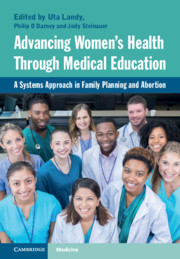 Advancing Women's Health Through Medical Education
Advancing Women's Health Through Medical Education Prevalence, Outcomes and Challenges
from Section II - Integration of Abortion into Graduate Medical Education
Published online by Cambridge University Press: 30 July 2021
Abortion is common medical procedure and the shortage of providers has been widely reported. This chapter describes the history of abortion training in the United States, including the establishment of the Ryan Residency Training Program, and reiterates that to meet patients’ needs, all clinicians who care for women’s reproductive health must be trained in abortion skills – including counseling, preoperative assessment, ultrasound, medication abortion management, uterine evacuation techniques, pain management, and postoperative care. This chapter describes the impacts of abortion training on learners’ clinical skills, attitudes toward patients and abortion provision, and on their professional practice. We describe the challenges in integrating abortion into resident curriculum, and how to find support and resources. We provide evidence of the many benefits of integrated training – including improving resident education and more comprehensive patient care, and argue that training in uterine evacuation skills is critical for all obstetrician-gynecologists.
To save this book to your Kindle, first ensure [email protected] is added to your Approved Personal Document E-mail List under your Personal Document Settings on the Manage Your Content and Devices page of your Amazon account. Then enter the ‘name’ part of your Kindle email address below. Find out more about saving to your Kindle.
Note you can select to save to either the @free.kindle.com or @kindle.com variations. ‘@free.kindle.com’ emails are free but can only be saved to your device when it is connected to wi-fi. ‘@kindle.com’ emails can be delivered even when you are not connected to wi-fi, but note that service fees apply.
Find out more about the Kindle Personal Document Service.
To save content items to your account, please confirm that you agree to abide by our usage policies. If this is the first time you use this feature, you will be asked to authorise Cambridge Core to connect with your account. Find out more about saving content to Dropbox.
To save content items to your account, please confirm that you agree to abide by our usage policies. If this is the first time you use this feature, you will be asked to authorise Cambridge Core to connect with your account. Find out more about saving content to Google Drive.